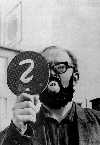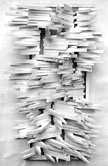 |
Vol 2, No 2 17 January 2000 |
action word movement space Czech experimental art of the 1960s Vít Havránek [Click on photos to see full image!] The conception of the exhibition and the catalogue "akce slovo pohyb, prostor" ("action word movement space," on at the City Gallery in Prague until 26 March 2000) constitutes a proposal to consider how today, at the end of 1999 and the beginning of 2000, one can understand the reverse side of Czech and Slovak art of the 1960s. When in 1966, Josef Hiršal - together with Bohumila Grögerová - prepared the publication slovo, písmo, akce, hlas (word, letter, action, voice), presenting the parallel trends of the 1960s in the rest of Europe in a condensed form, he made use of the term "experimental art" in order to set parameters. Hiršal and Grögerová included new types of artificial poetry, permutational and programmed art and happenings under the flag of experimental art, as their selection of manifestos, essays and artistic programs presented it. I believe that this publication constituted, in the Czech milieu, an important new interpretation of meanings and values, a new objectivization of theoretical criteria, which of course elicited little response in the field of art. Over the course of the 1960s, marked not only by political struggles but also by true theoretical polemics, two dominant trends took shape in art: Tachism, drawing on the strong domestic tradition of Surrealism (for which Czech Informel has become the established term); and Constructivism, in the Czech context, struggling against tradition and for recognition and a foundation for itself. The two spheres had strong personalities as their theoretical spokesmen; these personalities determined the basic parameters of the art of the 1960s in the Czech milieu and also delimited the later framework of interpretation in the 1970s and 1980s (the exhibitions of Czech Informel, the Poetry of Rationality, Czech Imaginative Art and so on).
As is clear from the title of the exhibition, I have chosen the above-mentioned publication by Josef Hiršal and Bohumila Grögerová as one of the points of departure. Another equally important factor influencing the current perspective on the 1960s is contemporary sensibility, to a certain extent determined by changes in the realms of technology and mass communication and the continuing social revolution.
Marshall McLuhan pioneered the theory of the media as an instrument of human experience. His work Understanding Media: The Extensions of Man, [1] published in 1964, introduced to the world the study of the role and influence of the media on human society. Only now can one understand the revolutionary applicability of his perspective, in which every technology gradually created for man a totally new environment, and environments were not passive packaging but active processes. The oft-cited slogan "the medium is the message" elegantly and briefly asserts that: "The effects of technology do not occur at the level of opinions or concepts but alter sense ratios or patterns of perception steadily and without any resistance." (p 18, English edition). Typical of the 1990s is an increasing tendency towards "synaesthesia." It is one of the strongest qualities of contemporary sensibility, introduced by the accumulation and linking up of technology. The most attractive impulse is that which has an impact on various senses simultaneously (sound, touch, sight, motion). In contrast to a more visual-literary culture (strictly divided and fragmented according to specializations), contemporary reality and contemporary art involve the participant in a much more intensive fashion through the medium of their synaesthetic impact - speculative, auditory, visual, kinetic. The contemporary world prefers art that is spatio-temporal, synaesthetic, dematerialized: synaesthetic art of a non-object character. This kind of art also demands a new viewer, a perceiver whose birth was described by the critic Jiří Padrta in a review of an exhibition of kinetic art. Padrta described this perceiver as a type, "highly active, open, not only in terms of sight, but also in terms of multiple-sense perception, able to register and emotionally grasp very diverse sensations at the same time." [2]
The manner of interpreting the 1960s proposed by the exhibition "action word movement space" is oriented towards the search for new criteria, deriving from the temporal structure of an artwork as a process, in contrast with the form-content polarity of Art Informel and Constructivism. In the great majority of "other" work, the process is more important than the actual artistic realization (the object).[3] The viewer is no longer confronted with a finished object but takes part in the artistic event. In those instances in which the new rules urge him to do so (happenings, interactive installations, varia-mobiles), the viewer directly co-creates the work; he participates physically and mentally and his freedom of interpretation of the event also increases. action
The second path of action art suppresses physical engagement and, instead, takes place in the space of ideas. It enriches the rules of thought according to which one guides oneself in life or by which one is guided. Life as a conceptual project (for example, the works of Július Koller). The instrument of the action is the text; the result of the action is an awareness leading to the undermining of the rules in effect in everyday life. word - order - chance Experimental poetry inspired
The reductive approach to art as a set of signs sharpened the organization inside the system into two polarities. The design composition method could oscillate between the order of the system (as in the works of Jan Kubíček) and chance (Zdeněk Sýkora's works, for example). motion
Detail, the structure of detail, moving detail, zoom in motion, motion without "motive," light dissonance, the breakdown of the world, the fluidly changing form (Nicolas Schöffer's anamorphosis, for example). Kinetic art combines the integration of real movement and electric light into the art object. This results in several important structural changes. The kinetic object is not de facto an object but a mechanism creating a kinetic performance. The kinetic performance acquires a temporal dimension (scenario) and becomes a composed event in time. On the level of the scenario-program, the kinetic work enters into the above-mentioned sphere of "permutation." Kineticism refreshes human sensibility. It uses technology; its pedigree is derived from Constructivism, and nonetheless - paradoxically - it turns the interest of the individual to the dynamic and mechanical aspects of the natural and universal settings and actions. in space Space became a crossroads of the expanding media:
From today's perspective, the 1960s were a time that introduced a wide range of new methods, from which the hybrid "synaesthetic" space of the 1990s emerged 30 years later. For "other" tendencies, a hybrid of approaches and techniques is characteristic, as well as a new interdisciplinary character (two or more traditional fields). The conflict between the revolutionary intentions of movements such as Fluxus and the Zero group - kinetic art and the environment on the one hand, and the museum manner of presentation of the authentic remains, in some cases photographs of actions in real time, on the other - recalls one of the essential qualities of the "other" approaches and their specific nature in contrast with the rest of the art world. The meaning of these experiments for our era consists in the involvement of the viewer, in his or her participation in the action taking place in the real time of the performing work. If one exhibits a fossilized object documenting a real action, one violates the meaning of the creative activity. The object used, the role of which had been secondary, indeed interchangeable, comes into the center of attention; it replaces the icon-art object with all its attributes. For an interpretation
Vít Havránek Translated by Kathleen Hayes The above is an abridged version of a text that appeared as the introduction to the catalogue for the exhibition "akce slovo pohyb prostor" ("action word movement space"), curated by Vít Havránek, which runs at the City Gallery in Prague until 26 March 2000. 1. Marshall McLuhan, Jak rozumět mediím [Czech translation of Understanding Media: The Extensions of Man, published in 1964 in New York, Toronto and London], Prague, 1991.
|
|
![]()
Copyright © 2000 - Central Europe Review and Internet servis, a.s.
All Rights
Reserved








